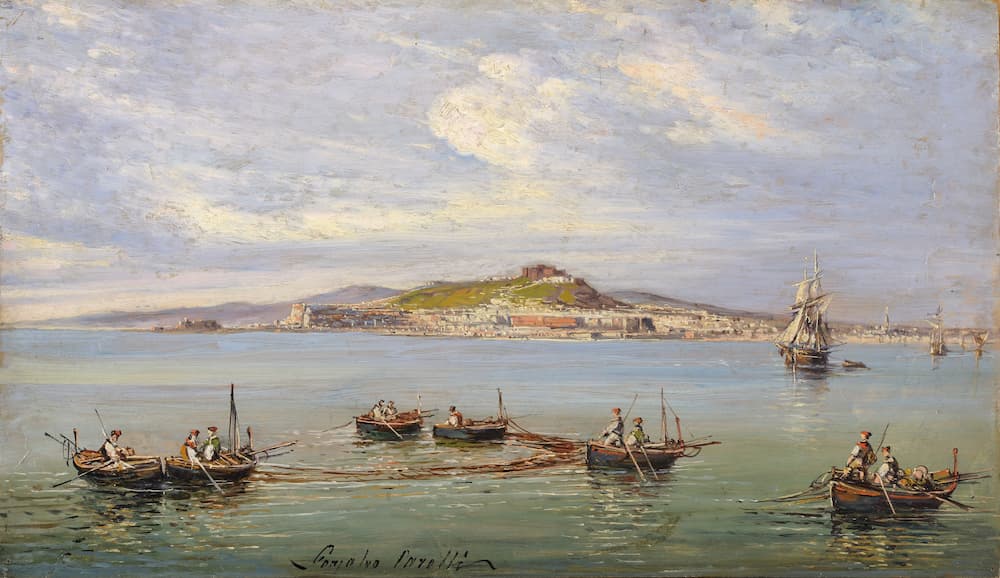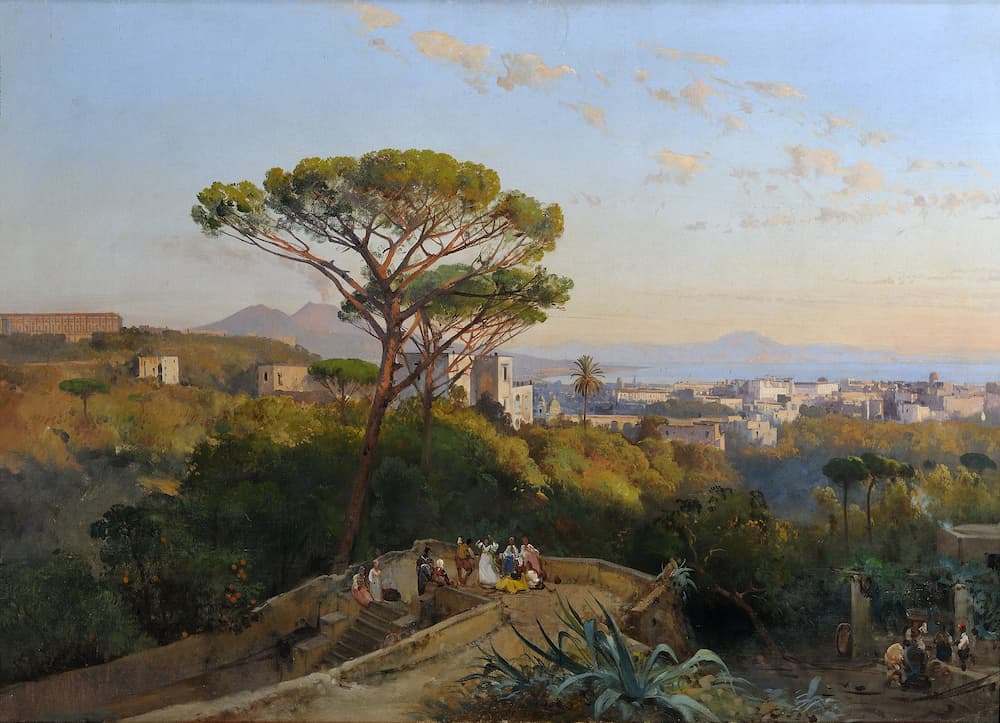Unprecedented exhibition opens on the day 23 from November for visitation with about 50 Italian and Brazilian paintings, in addition to photographs
With the bicentenary of the birth of D. Teresa Cristina (1822-2022), to exhibition “Landscape Colors – Naples-Rio in the eyes of 19th century Italian artists”, an initiative of the Italian Cultural Institute of Rio de Janeiro, open for visitation on the day 23 November, in the Imperial Palace.
The unpublished exhibition – and no roaming planned – intends to present how Naples and Rio de Janeiro met in the history of art, through the constructed look, for artistic creation, around the landscape of the two cities.
The exhibition brings together paintings by several Italian painters established in Brazil in the 19th century, among them Luigi Stallone, who came from Naples to teach painting to the empress of. Teresa Cristina, in addition to works by Edoardo de Martino, also Neapolitan that, after making a career in Rio de Janeiro, became Queen Victoria's British court painter and was successful with his night views, as well as Nicolau Facchinetti, author of the most celebrated views of Guanabara Bay (he had an intense performance as a painting teacher, with students like Maria Fornero, one of the few and outstanding women painters in Brazil in the 19th century).
The paintings from Italian museums gathered represent the two strands of Neapolitan landscape painting, which had great repercussions at the time., including Giant Giacinto screens, one of the masters of the School of Posillipo, and Marco de Gregorio, one of the outstanding names of the Escola de Resina.
The two groups of painters identified with localities in the Neapolitan region are known for renewing landscape painting in the 19th century, from a perspective that values the sensorial experience, exploring the variations of light and colors throughout the day and night, giving a subjective character to the environment.
This renewal of the look on the landscape is contemporary with the invention of photography. Thus, the exhibition also proposes a dialogue between the photographic creation of Camilo Vedani, the Italian landscape photographer who settled in Rio de Janeiro, in 1859, and the images by Giorgio Sommer, who at the same time became the best-known photographer in Naples.
“The exhibition brings a significant number of Italian paintings and photographs never before presented among us, establishing a dialogue between landscape painting in Brazil in the 19th century and Italian artistic creation in the Sicilian region of Naples at the same time. This dialogue is always mentioned by art critics, but rarely deepened due to lack of access to artistic images. On the other hand, the exhibition highlights the importance of the marriage of D. Pedro II as D. Teresa Cristina for the history of art in Brazil”, says curator, Paul Knauss.
For the director of the Italian Institute of Culture, Livia Raponi, creator of the project and responsible for the general design together with Knauss, “the importance and innovative character of this exhibition reside not only in the purely artistic, in the excellence of pictorial works, but also in the richness of themes and languages covered, presenting a dense web of cultural and anthropological relations between Naples and Rio, between Italy and Brazil, that goes through the music, exciting part of the exhibition route, archeology and photography”.
“Landscape Colors” is organized into four modules that explore the colors of day and night representation, from land and sea, passing through the black and white hues of photography, featuring a set of approx. 50 Italian and Brazilian paintings, dated 1844 to 1899, plus photographs from that time.
Os quadros vêm dos acervos from Certosa and Museum of San Martino and do Museo di Capodimonte, both in Naples, House of the Marquesa de Santos and Antonio Parreiras Museum (FUNARJ), Museum of Art of Rio/MAR, Museum of the Republic/Ibram, National Museum of Fine Arts / Ibram, Geyer House/Imperial Museum/Ibram, Museum of Life/Fiocruz, Naval Museum and National Library Foundation. The photographs belong to the Speranza Collection, italian private collection, and the Gilberto Ferrez Collection at Instituto Moreira Salles.
The exhibition is organized by the Italian Institute of Culture with Paço Imperial/IPHAN and has the support of the Consulate General of Italy in Rio de Janeiro and Generali. Curated by Paulo Knauss and jointly curated for Italian art by Fernanda Capobianco, the production is by Artepadilla.
About the exhibition
The story is known that Emperor D.. Pedro II was introduced to his future wife and Empress of Brazil, work. Teresa Cristina, through a portrait. The marriage would be celebrated through attorneys, in the city of Naples in the year of 1843, without the presence of the emperor.
Hence the importance of the framework, which represented the young princess of the Kingdom of the Two Sicilies accompanied by the landscape dominated by the presence of Mount Vesuvius, identifying his Neapolitan origin. The painting, by the Brazilian painter Correia Lima, repeated the formula of the portraits of Brazilian emperors who were distinguished by the presence of the carioca landscape with the Sugarloaf Mountain.
The landscape participated in the construction of political identities through art. However, the deepest political motivations of that time could be forgotten by the attractive power of the landscape of the Bay of Naples and Rio de Janeiro.
Giuseppe Garibaldi, for example, the revolutionary of two worlds, who fought, in the South of Brazil, in the Farroupilha Revolution and fought for the unification of Italy, assured, in your memories, that the experience of contemplating the bays of Naples and Rio de Janeiro made him feel like a poet.
Sign up to receive Event News
and the Universe of Arts first!
The revolutionary's declaration confirms the attraction power of the two port cities, respectively, from Italy and Brazil that share the natural context of a bay of protected waters that meets with a local relief marked by significant mountains associated with a sleeping giant.
No case of Naples, the reference is to the mount of the volcano Vesuvius, known as the dormant giant. In the case of Rio de Janeiro, the reference is to the whole of Serra do Mar, whose lines suggest the figure known as the sleeping giant, highlighting the Sugarloaf Mountain.
Learn more about Paul Knauss
Doctor of History, Professor of the Department of History at the Fluminense Federal University (UFF), member of the Brazilian Committee on Art History (CBHA) and member of the Brazilian Historical and Geographical Institute (IHGB), former director of the National Historical Museum.
As a researcher, he dedicates himself to Art relations, Image and Visual Culture, author of several published works, in addition to acting as curator of exhibitions.
Learn more about Livia Raponi
Director of the Italian Cultural Institute of Rio de Janeiro, is Cultural Attaché at the Ministry of Foreign Affairs of Italy. She holds a PhD in Letters from the University of São Paulo (USP). is an author, together with Joaquim M. Andrade, of the book “Italians behind the camera. Trajectories and remarkable perspectives in the flowering of photography in Brazil” (Ed. unesp, 2022).
Has extensive experience curating art exhibitions and intercultural events, developed as part of its work to promote the Italian language and culture.
Learn more about Fernanda Capobianco
She worked for many years as a historian at the Italian Ministry of Culture., having curated several exhibitions in Naples and abroad and director of the Export sector of Naples, do Diego Aragona Pignatelli Cortes Museum and do Park and Tomb of Virgil.
Published several studies on the collections of the museums of Naples, the history of Neapolitan sculpture and about the creation of the painter Giacinto Gigante. She has curated several exhibitions in Naples and abroad on 19th-century Neapolitan artists., among which the sculptors Vincenzo Gemito and Domenico Morelli.









Service:
“Landscape Colors – Naples-Rio in the eyes of 19th century Italian artists”
Curated by Paulo Knauss, curated by Fernanda Capobianco
Visitation: from 23 th November of 2022 to 12 February 2023
Free entrance
Local: Paço Imperial
Address: 15 November square, Center – RJ
Operation: Tuesday to Sunday and public holidays, from 12:00 to 6:00 pm
Press office: BriefCom Communications Advisory
Bia Sampaio +55 21 98181-8351; biasampaio@briefcom.com.br; @briefcomcomunicacao
Realization: Italian Institute of Culture of Rio de Janeiro and Artepadilla
Institutional support: Italian Embassy and Italian Consulate General in Rio de Janeiro
